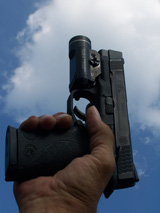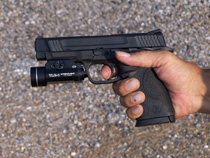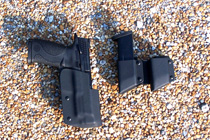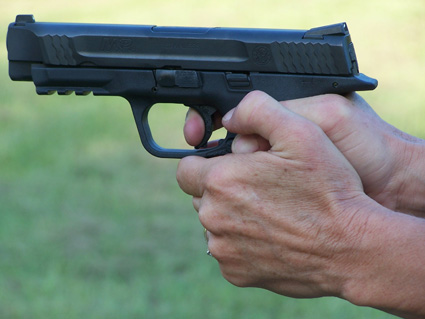In the early days of “police service automatic” adoption in the United States, Smith & Wesson pretty much owned the market. Then came Beretta, SIG SAUER, and the long since dominant Glock. Attempting to win back what had long been its core market, S&W went to great efforts to beat Glock at the polymer pistol game.
First came the Sigma, in the early ‘90s, designed by Kevin Foley. Unabashedly derivative of the Glock, it was perhaps too derivative, and cost the company beaucoup bucks plus a redesign job after Glock sued. The Sigma did not take off in the police market, and today has been repositioned as an economy grade pistol for the private sector, where it seems to sell pretty well.
Next came the SW99 series, a thinly disguised Walther. It didn’t take off either.
Advertisement — Continue Reading Below
RELATED: Best Glock Clones: Running Down 5 Great Imitators of the Icon
During 2006, underscored the old saying, “Third time’s the charm.” The brainchild of a design team led by former Colt engineer, Joe Bergeron, the Military & Police autopistol line was born in Springfield, Massachusetts, and the S&W M&P has been a hit ever since.
Beginning with a new sheet of drafting paper, the M&P is pretty much an original design. Some gun dealers are telling me that the M&P has become their best-selling handgun with caliber preference about equally split between 9mm and .40. S&W’s Julie Goloski has won a bunch of matches with the M&P 9mm, and so has her teammate, Ernest Langdon. At the Pennsylvania State IDPA championships in June 2007, I shot on the same squad with former national champ, Scott Warren, who was shooting a M&P .40. At matches around the country, I’m seeing more and more of the M&P 9mm pistols.
Advertisement — Continue Reading Below
The next two calibers on the list were .357SIG and .45ACP. Because the US government had expressed interest in testing .45ACPs for service-wide adoption, the .45ACP got preference in production scheduling. That contract has apparently drifted onto the military’s back burner, but it has left the rest of us with a helluva nice “.45 automatic.”
I first saw the .45ACP version in early 2007 at the SHOT Show in Orlando. S&W arranged a shooting day at an excellent local club, the Central Florida Rifle and Pistol. Smith was fronting the ammo, and my colleagues and I shot hundreds of rounds. We liked it.
My test gun didn’t come through until the summer of ’07. Demand was heavy, after all. Once it got there, everyone on my test crew was eager to shoot it, and the new pistol went through buckets of bullets.
Advertisement — Continue Reading Below
 Gun Details
Gun Details
The M&P .45ACP is distinguished from others in the series by the optional manual safety, which was on the government spec sheet for that tantalizing military contract. Mounted on the frame, it’s in a natural position for anyone accustomed to the thumb safety on a 1911 or High-Power, and it works in the same direction. The paddles are ambidextrous and just the right size for easy manipulation.
In deference to market demand, S&W decided when they introduced the M&P to offer it with or without the magazine disconnector safety, it makes it impossible to fire the chambered round with the magazine removed. A lot of cops swear by this device, because in a struggle for the gun, they can press the magazine eject button and “kill the pistol,” rendering it unshootable if the offender does succeed in getting it away from them.
At the same time, a lot of shooters like the idea of being able to fire the chambered round if the magazine is lost. I think there’s also a psychological thing going on, similar to our national dislike of automobiles that beep angrily when we don’t buckle our seat belts. We Americans don’t like being ordered.
Advertisement — Continue Reading Below
In the past, if an individual removed a magazine disconnector safety, a prosecutor would paint them as reckless and charge them with Manslaughter. A plaintiff’s lawyer could also sue for wrongful death, citing that the shooter is careless. “Ladies and gentlemen of the jury, how can you believe he is reasonable and prudent when he deactivates the safety devices on lethal weapons?”
By making it factory optional on the gun, S&W has taken that unmeritorious attack option away from opposing counsel. As one who goes into court to testify in shooting cases more often than the average bear, I appreciate that.
We have the same options in the .45ACP version of the M&P and more. the choice of having a manual safety or not. Many shooters are habituated to the cocked-and-locked carry of a 1911, and are more comfortable with an autoloader that has a manually operated safety lever. A number of police officers are alive today because the bad guy who stole their gun, tried to turned it on them by pulling the trigger and was frustrated because he couldn’t find the safety catch.
Advertisement — Continue Reading Below
The US military wanted a manual safety. Army and Marines both carry the M9 Beretta pistol on safe, and of course, Recon Marines and the Army’s Delta Force carry their 1911s the same way. Because an ergonomic manual safety had been designed into the M&P45 already, it was kept as an option for both police and private citizen sectors stateside.
You can order it without the safety if you like. Many do. You now have a choice of four flavors of M&P: (1) With the disconnector, but without a manual safety. It’s point and shoot and with the magazine out, it won’t go bang. (2) With the disconnector and with a manual safety. You now have the same two weapon retention options that S&W used to put on all their standard line service autos, going back to the classic Model 39 of 1954, and which the Browning Hi-Power has had since 1935. (3) Without the disconnector and without a manual safety. Basically, like a Glock. (4) Without the disconnector, but with a manual safety. Basically, like a 1911.
My test gun was of the latter persuasion. Laser etched on the right side of the pistol was the warning that the round in the chamber could be fired if the magazine was removed.
Advertisement — Continue Reading Below
Each of these pistols comes with three grip inserts that go on the back of the grip frame, and are quick to change out. They alter girth not only for the grasping fingers, but also for the web of the hand, which means that trigger reach is somewhat adjustable. You will want to play with these a bit before you make your decision as to which one will ride on your M&P .45 daily.
 I love the way the large one feels in my hand, but it doesn’t give me quite as good a trigger reach once the shooting starts. The medium fits better in that regard, and since I have a medium-sized hand that probably should have been my choice. However, I found myself shooting just a little bit better with the small insert in place. I got maximum reach to the trigger, and having less grip girth is like having more hand to wrap around the gun. It seemed to give me a tad more control. Try for yourself before you commit.
I love the way the large one feels in my hand, but it doesn’t give me quite as good a trigger reach once the shooting starts. The medium fits better in that regard, and since I have a medium-sized hand that probably should have been my choice. However, I found myself shooting just a little bit better with the small insert in place. I got maximum reach to the trigger, and having less grip girth is like having more hand to wrap around the gun. It seemed to give me a tad more control. Try for yourself before you commit.
The M&P’s Melonite finish is very good. The wavy grasping grooves provide good traction to the hand, though I know at least one civilian pistol packer who got away from his M&P and went back to the Glock because the edges of the slide serrations were biting into his flesh when he wore his M&P .40 tight to his body in a deep concealment belly band.
Advertisement — Continue Reading Below
The M&P service pistol has the trendy additional grasping grooves at the front. I don’t usually care for these, but because the M&P’s design allows the slide to be operated while the manual safety is up in the “on-safe” position, I found myself using the forward grooves to keep my fingers from hitting the safety levers.
Range Time
From the beginning, the M&Ps have been soft-kicking guns for their calibers. The .40s feel mild, the 9mms feel as if they’re not kicking at all, and the new .45ACP doesn’t really feel like a .45ACP. This speaks well for the ergonomics of the Bergeron design.
I tested the sample gun from my 25-yard bench on an MTM gun rest. I followed my usual protocol of measuring five-shot groups for an indication of how well the gun would group for an experienced shooter on a calm day with minimum wobble, and measuring again for the best three shots to factor out human error and to get a prediction of the pistol’s inherent mechanical accuracy.
Advertisement — Continue Reading Below
Winchester 230-grain Ranger high-tech hollow points have earned an excellent reputation “on the street” with American police departments. Five shots measured 3.6 inches center-to-center within the generous 4-inch limit generally specified as “acceptable service pistol accuracy.” However, the best three shots grouped only 1.35 inches apart. That was more like it.
Federal Classic 185-grain JHP was next. This is a soft-kicking load that has earned its chops on the street, and has also earned a reputation for extraordinary accuracy. It has frequently proven itself the most accurate ammo in various .45ACP tests, and came through again this time. The overall five-shot group measured 2.15 inches, and the best three cluster was an extraordinary 0.20 of an inch, a measurement center-to-center that was less than half the size of a single .45 hole. If multiple observers hadn’t been spotting the hits, we would have thought it was a double instead of a triple. The three hits were in one hole that measured 0.55 of an inch apart. The best four out of five hits were 1.15 inches.
The gun didn’t like one particular load for accuracy, but other than that, I have no complaints with it. Joe Bergeron designed the M&P .45 for battle, not competition, but interestingly enough it does pretty well in competition too.
My friend Chris Christian, an outdoor writer, is a big fan of the M&P and has been shooting the 9mm version for some months now in IDPA competition. In July of 2007, he used the .45ACP version (slick slide, no thumb safety and no disconnector) to shoot against the 1911s in the Custom Defense Pistol category at a match in Jacksonville, Florida. Chris came in first place overall in that division by a significant margin.
The only work done on the pistol, says Chris, “was LPA adjustable sights with fiber optic front. It’s the same setup as my 9mm. I also added skateboard tape to the front strap and slightly beveled the underside of the triggerguard on the right hand side to smooth it and remove the stippling. The factory configuration abrades my finger. I did the same treatment to my 9mm.”
His primary match load is a Rainier plated 230-grain JHP with 5.1 grains of Winchester 231 powder and Winchester large pistol primers. “The gun will do 2.5-inch, 25-yard bench rest groups with the Rainier handload and CorBon Performance Match,” says Chris, “and Federal Tactical HST +P and Hydra-Shok are in the 3-inch range. The other loads it likes seem to run 3 to 3.5 inches.”
 First Major Adoption
First Major Adoption
In third quarter 2007, it was announced that the New Hampshire State Police (NHSP) had adopted the M&P .45 as its standard issue service pistol. A source at S&W tells me they were ordered with the magazine disconnector safety, but without the manual safety or the other option, the internal lock mechanism.
This is a highly respected law enforcement agency with a national reputation for excellence. They have never stinted on the quality of firearms issued to their troopers. When the department was conceived in the 1930s, they were among the first in the nation to be issued S&W new heavy frame .357 Mag with 6- to 6.5-inch barrels. The long-barrel service revolvers swung in flap swivel holsters until the 1960s, when the department briefly went with the S&W Model 10 with 4-inch heavy barrel, and Jordan style scabbards.
The .38s didn’t last long, and by the ‘70s, troopers were carrying .357 Mags. They began with the K-frame Model 66, and then for durability reasons adopted the L-frame 686, both with 4-inch barrels. They got some of the early 686s that had problems, and switched to the Ruger GP100 .357Mag. In the early 1990s, the department went with the high capacity 9mm trend, adopting the S&W Model 5906, which carried 16 rounds. When field experience proved that the 147-grain subsonic 9mm hollowpoint they issued was nowhere near as effective as what they’d had before, the department announced an “upgrade” to .45ACP. The new gun was the S&W Model 4566. When those guns depreciated out after years of reliable service, SIG SAUER won the bid and the troopers were issued P220 all-stainless .45ACPs. Those are the pistols that the M&P will replace.
The .45ACP with, if memory serves, Winchester SXT/Ranger 230-grain JHP, has proven itself an admirable man-stopper for the troopers in the Granite State. Adoption of the M&P .45 brings them up to 11 rounds in the gun, instead of the nine they had before. NHSP has found the magazine disconnector to be a good thing, going so far as to special order their SIG SAUER P220 STs with that feature, which is not normally part of a SIG SAUER platform. That feature will be present on the new M&Ps, and gives the trooper wearing it an additional weapon retention strategy.
While NH gets credit for the first adoption of this gun in .45, the Iowa State Patrol adopted the M&P in .40 last year, and there is already an order in for M&Ps in .357SIG, which will become standard issue for the state troopers of New Mexico.
Final Notes
With the entire M&P series, S&W has listened to early complaints and immediately corrected them. This is something we don’t see as much of in the firearms industry as we should. The early slide stops were too hard to operate and that was changed immediately. Early M&P .40s were particularly susceptible to misfeeds from limp-wristing, and S&W quickly fixed that, too.
For southpaws, these are truly ambidextrous pistols with a slide stop/slide release lever on each side, ambidextrous thumb safety optional on the .45, and reversible magazine release. Considering the soft shooting characteristics and its good ergonomics, it’s a winner for righties too. And, most important, these .45 M&Ps have proven to be extraordinarily reliable.
My crew is passed 2,000 rounds fired with zero malfunctions. Remember, S&W engineered this gun to pass exhausting tests by the US military, which in recent production runs has a splendid reliability rate of approximately one malfunction per 20,000 rounds.
Leather is already out for it, with more coming. It is just barely larger than a 9mm or .40 M&P, and though it will fit a Blade-Tech holster for the smaller model if you loosen the screws enough, Blade-Tech is coming out with holsters and magazine pouches expressly for the M&P .45ACP. I spent a day carrying mine next to bare skin, under a polo shirt in a Deep Concealment IWB holster by Elmer McEvoy. It was perfectly comfortable, and nothing dug into my body. The Deep Concealment has built up leather on the body side that shields the skin from the slide serrations.
The fact that the S&W M&P .45ACP can be had with or without a manual safety and/or magazine disconnector safety, makes it versatile. In the meantime, we have another extremely reliable shootable high-tech, striker fired .45ACP.
Check out this review of the Smith & Wesson Spec Series V M&P Metal HD!























